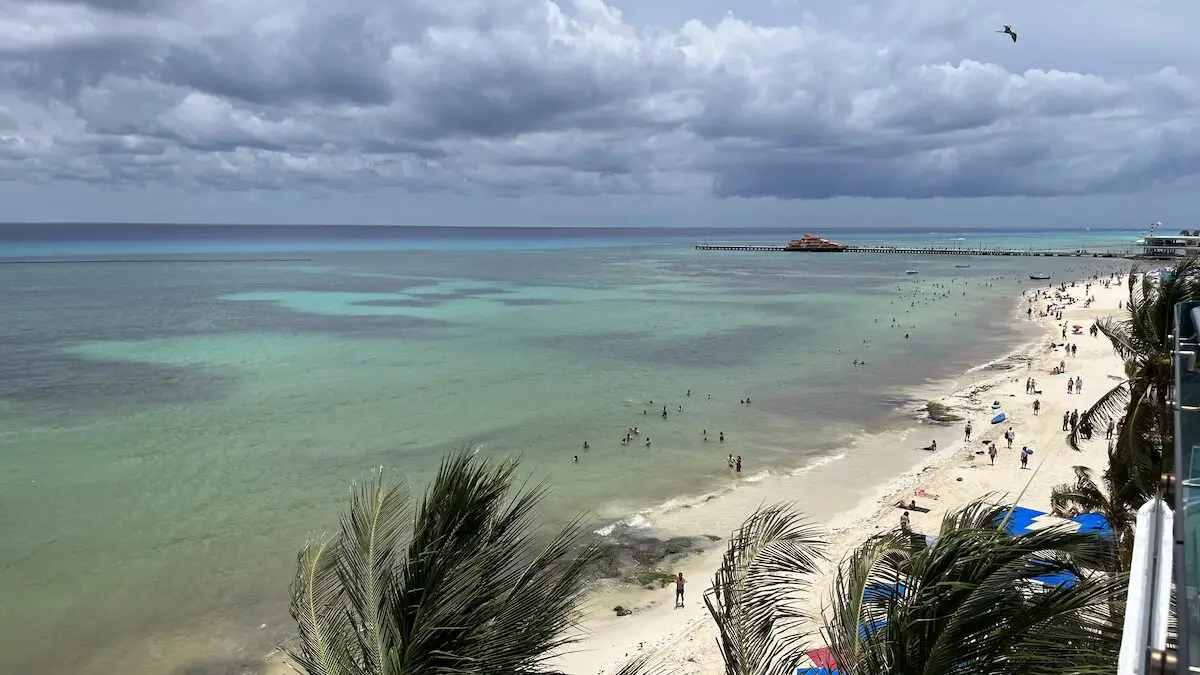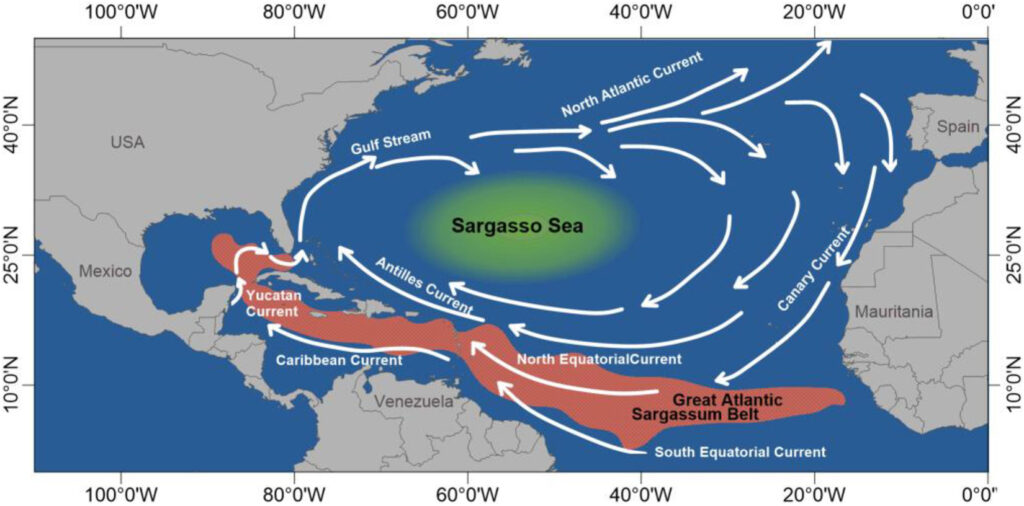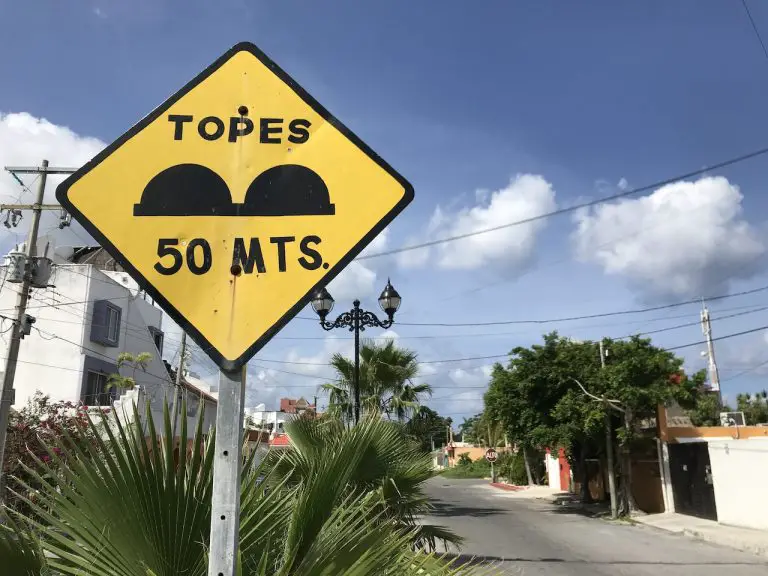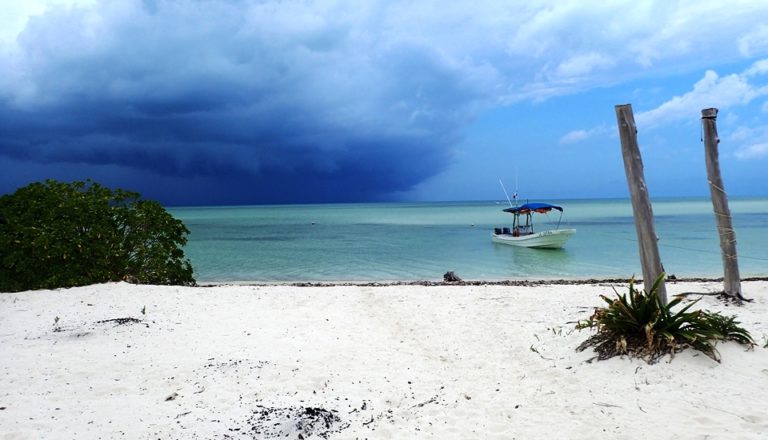Cozumel Unscathed by the Great Atlantic Sargassum Belt
Cozumel, Mexico is known for its glass clear waters and beautiful beachfront. But when the Great Atlantic Sargassum Belt (SAGB) began to expand in 2011 and plague beaches in Florida and the Caribbean with loads of stinky seaweed, it seemed like paradise might be in danger.
Cozumel remains nearly unaffected by the Caribbean sargassum problem in recent years.
With most of Cozumel’s large resorts, busy dive shops, and active downtown waterfront venues facing the West, along the leeward side of the island, the tourism zones are shielded from the large swaths of sargassum blooms that drift in from the Atlantic Ocean to the east.
This helps Cozumel remain an unspoiled beauty that welcomes an ever-increasing number of SCUBA divers, cruisers, and tourists from all over the globe. Most months, Cozumel’s most popular beaches and water activities are 95% free of sargassum and seaweed.
While other nearby destinations in the Caribbean sometimes struggle to cope with the influx of sargassum seaweed washing up on their primary beaches and shore attractions, Cozumel’s hot spots continue to remain largely unaffected by seaweed problems.
Cozumel Sargassum 2023
There are occasional weather patterns that push the sargassum toward the western coasts’ hotels and beach clubs, but that’s pretty rare.
And if and when it does happen, like it did in February of 2023, Mexico’s federal and local maritime and tourism agencies collect and remove the seaweed almost immediately, so it can’t pile up and decompose.

As reported in a recent USA Today article, this whole region can be affected by these “huge seaweed blobs” coming in from the east, and the amounts increase and decrease in various years, depending on many factors.
At the same time, maritime officials are solidly playing defense by installing additional miles of anti-sargassum barriers that successfully block and collect large blooms of seaweed before they get anywhere near the shore.
Experts had elevated quantities of seaweed in the Caribbean region in 2023, which according to reporting in NPR would likely peak in June or July.
However, things are looking good:
As of early July 2023, a combination of elevated water temperatures and ocean currents are moving the sargassum mass northward, which means Cozumel and the beaches along Mexico’s eastern coast – namely Cancun, Playa del Carmen, and Tulum – will be spared from significant amounts of seaweed this summer.
And up to now, various beaches throughout the state of Quintana Roo where Cozumel, Playa, and Cancun are located, have already reported far lower numbers than expected.
Good news for 2023, so far!
So, overall, there can be no guarantees exactly, but the vast majority of Cozumel hotels, beach clubs, and dive sites on the western shore remain mostly clear of sargassum.
There is sometimes, however, an issue on the east side of the island where there are a few beach clubs and restaurants. You can certainly still swim and enjoy the views, but you will need to wade through some harmless seaweed on certain days.
What makes this Mexican getaway so special? How does the Cozumel national marine park, and its most populated coastal resorts and restaurants remain seaweed free?

The History and Ecology Of The Sargasso Sea
The Sargasso Sea is an area of the Atlantic Ocean that’s surrounded by four powerful currents, creating a distinct sea without physical land borders. It’s a phenomenon that creates its own unique ecosystem, but what does it have to do with Cozumel?
Since a major increase in size back in 2011, the Sargasso Sea begat what’s now known as the ‘Great Atlantic Sargassum Belt’ (GASB).

This mass of sargassum expands and declines at different rates each year, depending on various factors like nutrient supply, ocean temperatures, and sunlight. Ocean current patterns cause it to make its way West into the Caribbean area, and the Eastern coastal cities of Mexico, every year in the Summertime, peaking around July, typically.
While other parts of the Caribbean are being inundated with tons of sargassum seaweed washing up on their east coast beaches, Cozumel has been able to remain unscathed thanks to its orientation, facing away from this massive incoming belt of seaweed.
Thanks to geography, and the history of Cozumel settlement on the West side of the island, Cozumel typically stays free from large-scale sargassum beaching events. This in turn allows for healthy coral reefs and aquatic life to flourish along its Western coastlines.
But why did sargassum blooms increase dramatically in 2011? That’s something we’ll explore next.
Why Did Caribbean Sargassum Blooms Increase In 2011?
Cozumel, like so many other Caribbean islands, is no stranger to the threat of sargassum blooms.
In recent years the occurrence of these blooms has been on the rise and it all started back in 2011 when a massive bloom was discovered in the Atlantic Ocean, possibly caused by the effects of a large storm in 2010.
This increase in sargassum blooms can be attributed to certain environmental factors such as warming ocean temperatures and river- and development runoff from African countries.
While each factor plays its part, ultimately it’s a combination of them which resulted in what we’re seeing now: masses of seaweed washing up onto shorelines around the world.
What are the three main drivers behind ongoing sargassum blooms in recent years?

Main Drivers Behind Ongoing Sargassum Blooms In Recent Years
The island of Cozumel’s main tourist areas have been luckily spared from seaweed problems, while other areas have suffered. But it begs the question: Can anything be done to prevent the sargassum waves in the first place? What are the three main drivers behind ongoing sargassum blooms in recent years?
Basically, a combination of factors such as climate change, ocean currents and nutrient runoff can all contribute to a rapid increase in the Sargassum belt’s mass and growth.
There Are Actually Some Good Things About Sargassum Patches
While many people focus on the negative aspects of increased Sargassum growth, there are actually some good things about patches forming in certain areas as well.
These include providing food for marine life and increasing marine biodiversity.
Sylvia Earle, an ocean explorer, has referred to the islands of sargassum that float freely in the Atlantic Ocean as “a golden floating rainforest”.
This unique marine habitat comprises several round “berries” filled with gas. It provides a range of benefits including food, protection, and breeding grounds for an array of marine species like crabs, shrimp, sea turtles, migratory birds and 120 species of fish.

Additionally, these sargassum mats provide the only spawning grounds for various eels found in Cozumel, as well as 43 different threatened or endangered animals.
So while we should continue to strive towards reducing our impact on our environment, it’s important to recognize that sometimes nature finds ways to help us too.
Does Sargassum Harm Cozumel Tourism?
Sargassum seaweed, a type of algae found in the Atlantic Ocean, has been wreaking havoc on some Caribbean tourism areas over the past few years, with a peak problem in 2018.
This is largely due to its tendency to pile up along shorelines, creating large piles of unsightly seaweed that attract bugs and have unpleasant odors that interfere with beachgoers’ enjoyment of their vacations.
To make matters worse, large patches of sargassum on the surface waters may block sunlight to coral reefs, or deplete oxygen levels in the ocean, leading to compromised growth and even some marine life die-offs.
The damage done by this invasive species can’t be underestimated; it takes a toll on both businesses and local ecosystems.
Luckily, as explained above, Cozumel island’s positioning and its commitment to mitigation makes sargassum issues far less damaging than other Caribbean destination.
Hotels on the mainland hot spots like Playa del Carmen, Cancun, and Tulum, however, have had to curtail business due to overwhelming seaweed piles washing ashore.
It’s clear that the GASB poses an ongoing threat to Caribbean tourism – but luckily for some destinations like Cozumel, they’re able to skirt such issues thanks to their strategic leeward orientation and their robust prevention efforts.
Cozumel’s Leeward Orientation Saves it from The Seaweed Pileups
It’s really lucky that Cozumel’s main tourism and residential areas have been mostly unscathed by the great Atlantic Sargassum belt. With its leeward orientation, the Island has managed to avoid most of the seaweed pileups that have become all too common in nearby Caribbean islands.
This is due to two factors: firstly, the prevailing trade winds help keep sargassum away from shorelines; secondly, currents and tides often carry it out into deeper waters offshore. Put together, these natural elements mean beachgoers can enjoy their vacation without worrying about uninvited guests washing up on the sand.
Cozumel’s East Side of the island, a.k.a. The Other Side or The Wild Side, does suffer from seaweed piles on years that the sargassum blooms are especially bad, however.
East Coast beaches like Chen Rio, Playa San Martin, and some favorite day-drinking spots like Coconuts and Welcome to Miami do face the scourge of seaweed, and have to rake, collect, and otherwise try to manage it daily when the conditions are poor.

The fact remains that a few beaches are affected while others get off scot free – so what’s the specific story for Cozumel and seaweed? Which beaches are impacted by sargassum…and which ones aren’t?
Which Cozumel Beaches Are Impacted By Sargassum?
As a general rule, the resorts, hotels, restaurants and beach clubs along the Western coast of Cozumel do not have a sargassum problem, even during the high month of July. The island has occasional and very small amounts of seaweed that drift by, and sometimes get caught up in small inlet coves or especially rocky beach fronts.
But the volume is negligible, and whatever small amounts may be around are pretty easily cleaned up.
If you’re scuba diving, you may see some here and there as you ascend to the surface, but it is simply not an issue.
Seaweed Does Affect Cozumel’s Wild Side
The East side beaches and restaurants might be impacted during the summer months, though there are mitigation factors in place now, like booms to keep seaweed off the shore, and/or beach cleanup protocols at those places.
Check These Popular Cozumel Beach Venues Before Going:
- Rastas Bar
- Welcome to Miami
- Playa Bonita
- Playa San Martin
- Playa Chen Rio
- Coconuts
- Playa Punta Morena
- Senior Iguana’s
- Mezcalito’s
A drive over to the other side is still a great time, even if sargassum happens to be in bloom. You just might not want to wade through it to go swimming – though it’s not that bad, it’s doable, and the water beyond will be just as nice.
TIP: In order to get the most out of your visit to Cozumel, it’s important to do research before you go so you know which beaches may be impacted by sargassum buildup and which can safely be visited without worry.
That way, you can make sure every moment spent at this beautiful destination is as enjoyable as possible!
Scuba Diving In Cozumel Is Fortunately Not Affected
Are you a scuba diver looking to explore the breathtaking depths of Cozumel? Well, fortunately for you, Cozumel diving is in no way impacted by sargassum.

Frequently Asked Questions
How Can Cozumel Protect Its Beaches From Sargassum In The Future?
Cozumel’s beaches were mostly spared by the recent great Atlantic sargassum belt seasons. But how can this Caribbean diving and tourism mecca protect its shorelines in the future?
To address this question, it’s important to look at the underlying causes of sargassum growth and consider what preventative steps could be taken, and soon it’s clearly more of a global issue. To start with, coastal development projects around the world should truly be accountable for preventing fertilizer and chemical runoff into our rivers and oceans, but…we know how that goes.
How Can The Public Help Reduce Sargassum Blooms?
The public can play a role in protecting our beaches and preserving the beauty of Cozumel.
Check here for some of Cozumel’s most eco-friendly excursions and activities.
Are There Any Long-Term Effects Of Sargassum On The Environment?
The impact of sargassum can be far reaching. Aside from smothering coral reefs, it also affects coastal communities by blocking sunlight and oxygen needed for seagrasses, which likely affects the survival and replenishment of juvenile species. This destruction can lead to potential collapse of food webs, both nearshore and offshore. Moreover, dead or decaying sargassum releases nutrients into the water which encourages additional algal blooms – leading to an imbalance on coral, and further disruption of local aquatic habitats.
These dangers make it essential we take steps to mitigate their effects. Fortunately, there are several ways we can do this such as restoring degraded mangroves and seagrasses, using artificial barriers to prevent the influx of sargassum onto shorelines, and ongoing research into the sustainable use of excess sargassum as biomass/biofuels and construction raw materials.
Is the Mainland of Mexico Affected By Sargassum Blooms?
Sargassum blooms have had a negative impact on many Caribbean islands in recent years. While Cozumel, thankfully, managed to dodge any major damage from the Great Atlantic Sargassum Belt, other parts of the Mexican Caribbean tourist region haven’t been so lucky.
Cancun, Tulum, and Playa del Carmen all have eastern facing shorelines, and the development of hotel zones, commerce, and waterfront recreation to go with it.
Through the use of defensive aquatic booms to block and collect the seaweed, as well as daily maintenance and management of the sargassum that still does make it to shore, these hotspots are still enjoyable and well-worth visiting. Just be forewarned, and patient and understanding if you are planning your trip during months when this is even a concern – namely June and July.
Can Cozumel Remain Sargassum-Free?
The Great Atlantic Sargassum Belt has been a unique challenge for Cozumel and other Caribbean islands. With the luck of geography and careful management of their beaches, Cozumel has remained largely unharmed by this phenomenon.
The Sargasso Sea is home to many species of marine wildlife, including seahorses, sea turtles, eels, and jellyfish. Although it’s not clear what long-term effects sargassum will have on the environment, it’s important to recognize how this natural event affects our planet as a whole.
Finally, while Cozumel may have weathered the storm so far, other nearby islands will surely still struggle with sargassum blooms that threaten their livelihoods. We must continue to work together to protect our shores from future damage and preserve these beautiful places for generations to come.
CozInfo’s Cozumel Packing Essentials:
|
Primary Rating:
3.5
|
Primary Rating:
3.5
|
Primary Rating:
3.5
|
Primary Rating:
3.5
|
|
$20.99
|
$279.00
|
$59.95
|
$20.99
|











